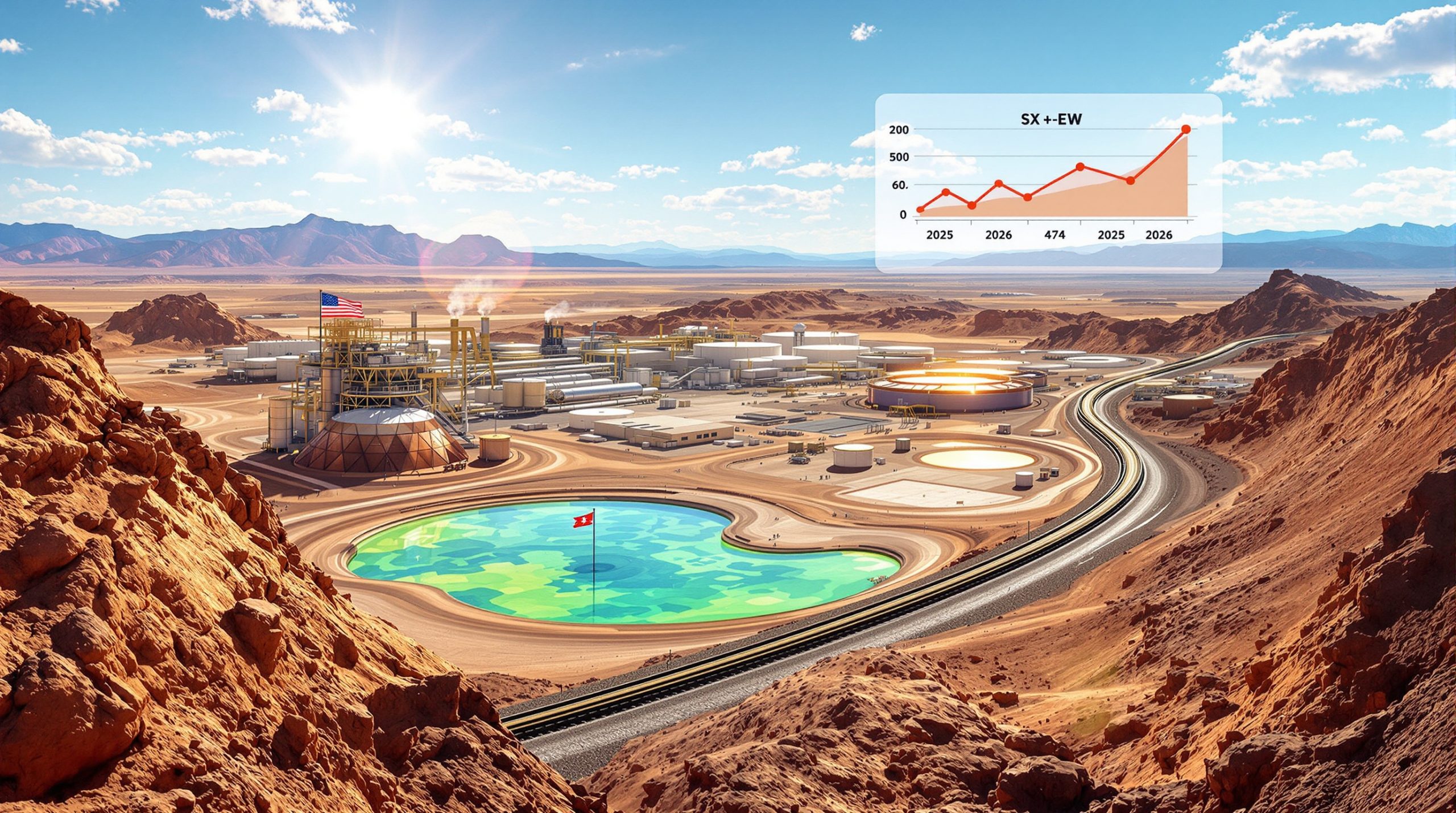The Looming Copper Crisis: How Supply Disruptions Will Impact Semiconductor Production
Climate change is creating an unprecedented threat to the global semiconductor industry through its impact on copper mining operations. According to a recent PwC report, water scarcity across major copper-producing regions could severely disrupt the supply chain that powers our digital world. As droughts intensify and water resources become increasingly stressed, the semiconductor industry faces a challenging future where a third of chip production could face copper supply disruptions by 2035.
The copper-semiconductor relationship represents a critical vulnerability in the global technology ecosystem—one that requires immediate attention from industry leaders, policymakers, and researchers to prevent potentially devastating economic consequences.
What Percentage of Global Chip Production Is at Risk by 2035?
The Growing Threat to Semiconductor Supply Chains
According to PricewaterhouseCoopers' (PwC) comprehensive analysis, approximately 32% of global semiconductor production could face climate change-related copper supply disruptions by 2035. This represents a quadruple increase from today's already concerning risk levels, creating significant vulnerabilities across the global technology supply chain.
"By 2035, most of the 17 countries supplying the chip industry will be at risk of drought," warns PwC's analysis, with project lead Glenn Burm emphasizing that "the risk will only increase over time if innovation on materials does not adapt to climate change."
This dramatic escalation in supply chain vulnerability comes at a time when copper demand surges, driven by artificial intelligence, cloud computing, and the proliferation of connected devices.
Economic Impact of Previous Chip Shortages
The semiconductor industry already has a cautionary tale about supply chain disruptions. The most recent global chip shortage provided a stark demonstration of how deeply semiconductor constraints can affect the broader economy:
- Cost the U.S. economy a full percentage point in GDP growth
- Reduced Germany's economic growth by 2.4%
- Crippled automotive manufacturing worldwide, forcing production shutdowns
- Created bottlenecks across multiple sectors dependent on semiconductor components
These impacts emerged from production and logistics disruptions—not from fundamental material constraints. A copper price collapse would potentially create more severe and longer-lasting effects, as finding alternative materials presents significantly greater challenges than solving logistics issues.
Which Countries Face the Highest Copper Supply Risks?
Chile's Escalating Water Crisis
Chile, which provides approximately 28% of the world's copper supply, stands at the epicenter of this looming crisis. The country already grapples with water shortages that are slowing down production in some regions.
According to PwC's detailed analysis:
- 25% of Chile's copper production is at risk of disruptions today
- This vulnerability rises dramatically to 75% within the next decade
- By 2050, between 90% and 100% of Chile's copper production could be affected
The Atacama Desert region, home to many of Chile's most productive copper mines, is particularly vulnerable to intensifying water stress. Mining operations in this area already compete with local communities and agriculture for increasingly scarce water resources.
Global Spread of Water-Related Mining Risks
The copper supply vulnerability extends far beyond Chile. By 2035, most of the 17 countries supplying copper to the semiconductor industry will face significant drought risks, including:
- China
- Australia
- Peru
- Brazil
- United States
- Democratic Republic of Congo
- Mexico
- Zambia
- Mongolia
Each of these countries faces unique challenges based on their geography, existing water infrastructure, and the specific locations of their copper deposits. However, PwC's analysis indicates that no major copper-producing region will be completely immune to the impacts of climate change on water availability, which could significantly affect the global copper supply forecast.
"Around half of every country's copper supply is at risk by 2050 – no matter how fast the world reduces carbon emissions," the PwC report states, highlighting the need for adaptation strategies regardless of climate mitigation efforts.
Why Is Copper Critical for Semiconductor Manufacturing?
The Irreplaceable Role of Copper in Chips
Copper serves as an absolutely fundamental material in semiconductor manufacturing for several crucial reasons:
- Circuitry foundation: Copper is used to create the billions of tiny wires inside every chip's circuit
- Superior conductivity: Copper offers exceptional electrical conductivity, minimizing energy loss
- Heat dissipation: Copper efficiently dissipates heat, a critical factor in chip performance
- Cost-effectiveness: Despite price fluctuations, copper remains economically viable at scale
- Manufacturing compatibility: Existing fabrication processes are optimized for copper integration
As PwC's assessment concludes, there is "currently no match for its price and performance" in semiconductor manufacturing applications. This creates a situation where the industry has little flexibility to pivot away from copper dependency in the short to medium term, making copper price insights increasingly valuable for industry planning.
Research Challenges for Alternative Materials
While research into copper alternatives continues across multiple fronts, significant barriers remain before any potential replacements could be implemented at scale:
- Conductivity trade-offs: Alternative materials typically offer lower electrical conductivity
- Cost barriers: Materials like silver or gold provide better conductivity but at prohibitively higher costs
- Manufacturing complexity: New materials would require substantial retooling of production processes
- Reliability concerns: Alternatives often haven't demonstrated the same long-term durability
- Scale limitations: Many promising alternatives face challenges in mass production
The semiconductor industry operates on extremely fine margins of performance, where even minor reductions in conductivity or increases in manufacturing complexity can render a technology commercially nonviable.
What Climate Change Impacts Threaten Copper Mining?
Drought as the Primary Threat
Water scarcity represents the most significant climate-related risk to copper production, creating multiple operational challenges:
- Extraction dependency: Mining operations require substantial water resources for ore processing
- Water intensity: Producing a single tonne of copper concentrate requires 30-50 cubic meters of water
- Competition for resources: Mining operations increasingly compete with local communities
- Regulatory restrictions: Water use limitations are becoming more common in drought-affected regions
- Operational disruptions: Insufficient water supply forces production slowdowns or shutdowns
Chile provides a clear example of these challenges, as its operations are already experiencing production impacts due to water shortages. As climate change intensifies, these constraints will likely become more severe and widespread, affecting copper market trends globally.
Long-Term Climate Projections for Mining Regions
PwC's analysis reveals a concerning trajectory regardless of climate action:
- Approximately 50% of every country's copper supply will be at risk by 2050
- This outcome persists even with aggressive carbon emission reductions
- Long-term planning is complicated by uncertainty in regional precipitation patterns
- Increasing temperature extremes will further stress water resources in many mining regions
- Glacial retreat threatens water supply in several key South American mining areas
These projections indicate that adaptation strategies must be developed and implemented regardless of global climate mitigation efforts, as many impacts are already locked in due to existing greenhouse gas concentrations.
How Are Copper-Producing Countries Responding?
Adaptation Strategies in South America
Chile and Peru, recognizing the existential threat to their mining industries, have implemented several innovative measures to secure their water supplies:
- Desalination infrastructure: Building large-scale plants to convert seawater for mining use
- Efficiency improvements: Implementing technologies that reduce water consumption per ton of copper
- Water recycling systems: Developing closed-loop systems that minimize freshwater requirements
- Regulatory frameworks: Creating water management policies that balance competing needs
- Alternative extraction methods: Researching less water-intensive mining techniques
These initiatives represent substantial investments but demonstrate the economic rationality of adaptation in regions where mining constitutes a significant portion of national GDP.
Limitations for Inland Mining Regions
While coastal nations can leverage desalination technology, this approach has significant limitations:
- Geographic constraints: Countries without access to seawater cannot utilize desalination
- Transportation challenges: Moving desalinated water inland increases costs by 30-50%
- Energy requirements: Desalination requires substantial electricity, creating carbon intensity concerns
- Environmental impacts: Brine disposal creates additional ecological challenges
- Economic viability: Cost-benefit calculations vary dramatically by location
For inland mining operations in places like the Democratic Republic of Congo, Mongolia, and Zambia, alternative water security strategies must be developed that account for their specific geographic and economic contexts.
What Are the Implications for the Semiconductor Industry?
Supply Chain Vulnerabilities
The semiconductor industry must prepare for several challenging scenarios:
- Price volatility: Copper cost fluctuations will likely increase as supply constraints intensify
- Extended lead times: Material procurement windows may expand significantly
- Quality variations: Water stress can impact copper purity and processing consistency
- Geographic concentration risk: Disruptions in key regions could create global ripple effects
- Competitive procurement: Increased competition with other industries for available copper
These vulnerabilities require proactive management to prevent production disruptions that could cascade through global technology supply chains.
Strategic Responses for Chip Manufacturers
To address these challenges, semiconductor companies should consider a multi-faceted approach:
- Supply diversification: Sourcing copper from multiple geographic regions
- Inventory management: Building strategic reserves of critical materials
- Design optimization: Developing chips that require less copper per unit of performance
- Recycling initiatives: Investing in technologies to recover copper from electronic waste
- Vertical integration: Forming strategic partnerships with mining companies
- Material research: Accelerating development of alternative conductors for specific applications
Companies that implement these strategies early may gain significant competitive advantages as constraints intensify over the coming decades.
How Might Copper Supply Issues Impact Technology Development?
Artificial Intelligence and High-Performance Computing
Advanced computing technologies are particularly vulnerable to copper supply disruptions:
- Data center infrastructure: AI facilities require 5-8 times more copper than traditional data centers
- GPU manufacturing: High-performance chips contain significantly more copper interconnects
- Cooling systems: Advanced thermal management relies heavily on copper components
- Power delivery: AI's enormous energy demands require substantial copper in power infrastructure
- Scaling limitations: Material constraints could slow the exponential growth in AI capabilities
As demand for AI and high-performance computing continues to accelerate, these sectors may face difficult trade-offs between performance, cost, and availability.
Consumer Electronics and Automotive Sectors
Downstream industries will also feel the effects of copper supply challenges:
- Product cost increases: Material constraints will likely drive component price inflation
- Development timeline extensions: Design cycles may lengthen to accommodate material alternatives
- Feature prioritization: Manufacturers may need to choose which capabilities to maintain
- Electric vehicle delays: EV production (which requires 130% more copper than traditional vehicles) may face constraints
- IoT deployment slowdowns: Connected device proliferation depends on copper availability
These impacts could significantly alter product roadmaps and market dynamics across multiple technology sectors, potentially slowing innovation in consumer-facing technologies.
What Solutions Could Address the Copper Supply Challenge?
Technological Innovations
Several technological approaches offer promise for mitigating copper supply risks:
- Advanced recycling: New technologies can recover over 95% of copper from electronic waste
- Material efficiency: Chip designs that reduce copper usage without sacrificing performance
- Alternative conductors: Graphene, carbon nanotubes, and aluminum alloys for specific applications
- Mining innovations: Less water-intensive extraction and processing methods
- Miniaturization advances: Further reducing material requirements through design optimization
The semiconductor industry has a strong track record of overcoming material constraints through innovation, suggesting that technological solutions will emerge—though the transition timeline remains uncertain.
Policy and Industry Collaboration
Broader collaborative efforts will be essential to address the systemic nature of the challenge:
- International water agreements: Frameworks for managing shared water resources in mining regions
- Research funding: Public-private partnerships to accelerate material science breakthroughs
- Infrastructure investment: Development of water security projects in vulnerable regions
- Industry standards: Common approaches to material efficiency and recycling
- Supply chain transparency: Better visibility into copper sourcing and vulnerability assessment
The Chile-Peru water security initiatives provide a model for how coordinated action can reduce vulnerability while maintaining production capacity.
FAQ: Copper Supply and Semiconductor Production
How does water scarcity affect copper mining operations?
Water is essential throughout the copper extraction and processing workflow. Mining operations use water for dust suppression, ore processing, concentrate production, and waste management. Drought conditions force operations to reduce production volumes, seek costlier water alternatives, or temporarily suspend activities. The water intensity of copper production—requiring 30-50 cubic meters per tonne of concentrate—makes mining particularly vulnerable to hydrological changes.
Could recycling help address copper supply challenges?
Recycling offers a partial solution but cannot fully address the challenge. While advanced recycling technologies can recover over 95% of copper from electronic waste, several limitations exist:
- Collection infrastructure remains incomplete in many regions
- Consumer electronics retention delays the recycling timeline
- Processing capacity would need significant expansion
- Semiconductor manufacturing requires exceptionally high-purity copper
Recycling will play an increasingly important role but must be complemented by other strategies.
Will copper prices increase due to these supply disruptions?
Economic analysis suggests copper prices will likely experience both upward pressure and increased volatility. Supply constraints typically drive commodity price increases, and the semiconductor industry's inelastic demand (due to lack of alternatives) means manufacturers may absorb significant price increases before altering production. This could create challenging cost structures for chip manufacturers and downstream industries.
Are there any regions that will remain unaffected by water-related copper supply risks?
According to PwC's analysis, no major copper-producing region will be completely immune to water-related risks by 2035. However, the severity varies significantly by location. Regions with naturally abundant water resources, effective water management infrastructure, and less extreme climate projections may maintain more stable production. However, the interconnected nature of global supply chains means that disruptions in any major producing region will have ripple effects worldwide.
How might these supply challenges affect everyday consumers?
Consumers may experience several impacts as copper constraints affect the semiconductor supply chain:
- Higher prices for electronic devices and vehicles
- Longer wait times for new product releases
- Potential reduction in certain feature improvements
- Shifts in product design prioritizing material efficiency
- Increased emphasis on device longevity and repairability
The severity of these impacts will depend on how successfully the industry implements mitigation strategies and technological innovations, according to a recent analysis by PwC.
Disclaimer: This analysis represents projections based on current climate and industry trends. Actual outcomes may vary based on technological developments, climate mitigation efforts, and adaptation strategies implemented by industry and governments.
Looking to Stay Ahead of Critical Mining Developments?
Discover the next major mineral opportunity before the market with Discovery Alert's proprietary Discovery IQ model, delivering real-time notifications on significant ASX mining announcements across 30+ commodities. Explore how historic discoveries have generated substantial returns by visiting the dedicated discoveries page and position yourself for success in the evolving resources sector.




